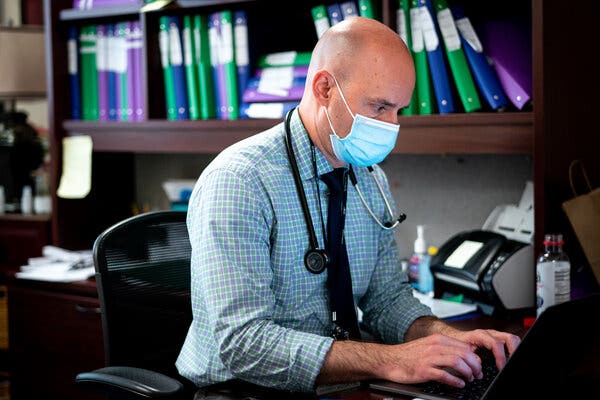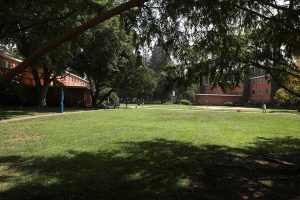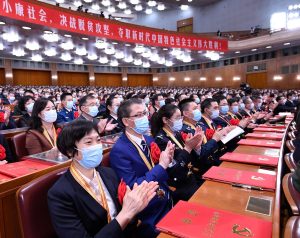WASHINGTON — The unfamiliar voice on my cellphone three weeks ago had the “You have been selected” greeting that usually signals someone trying to sell you something. But this was no telemarketer.
I had been chosen, the woman said, “to participate in the Moderna Covid-19 vaccine trial.” She introduced herself as Hira Qadir, a clinical research coordinator at George Washington University. I was tediously stirring a roux for the seafood gumbo I was making for dinner, and her startling announcement stopped me cold.
In an instant, a dozen emotions ran through me, chief among them fear.
In late July, Dr. Anthony S. Fauci, the government’s top infectious disease expert, had testified before Congress that volunteers were needed for vaccine trials that were continuing. I had gone to the website — www.coronaviruspreventionnetwork.org — and filled out the questionnaire with my medical history and personal information.
“I signed up for a Covid vaccine trial,” I texted a group of friends, all reporters with smart mouths on them. But one response gave me pause.
“I admire your dedication to the cause,” my friend Mark Mazzetti told me. But he was clear in his text: “You gotta be really careful given your underlying condition. You could be given a placebo and sent to hang out in hot spots.”
I hadn’t thought of the placebo part of the vaccine trial when I signed up. I am a Type 1 diabetic — a chronic autoimmune disorder I have had since I was 15, with asthma to boot, so I am firmly in the high-risk category. That had been made clear to me by Dr. Fauci himself in early March when I ran into him in the green room for NBC’s “Meet the Press.”
“What happens if I get Covid?” I had asked him.
“I’m not saying you’re a dead duck,” he replied, “but I cannot stress enough that you really need to not get it.”
That day, I went home and put into place what I called my Ebola protocols, the same behavior that had worked for me in 2014 when I was covering the Ebola pandemic in Liberia. No touching. Rigorous hand-washing. Disinfectants. I had known then that if I caught Ebola, I would probably be skirting dangerously close to Dr. Fauci’s dead duck.
My hope was that the coronavirus, while more contagious, was not quite as deadly. But I needed to not get it.
On the phone, Ms. Qadir assured me that this was Phase 3, presumably past the point where Jennifer Ehle vaccinated herself in the movie “Contagion” and then wandered through a ward full of sick and dying people to test her vaccine. Whether I received the vaccine or a placebo, she said, I was expected to continue my normal routine, which for me also consisted of working from home and wearing a mask when I went out.
“But then what’s the point?” I asked.
“We want you because you’re diabetic,” she said. “We need to know if it’s safe for diabetics.”
Also, she added, Moderna needed more minority participants. If I got the placebo and Moderna decided its vaccine actually worked, I would be given the real vaccine, she said. And if another company developed a vaccine first, I could not be stopped from taking that one and pulling out of the Moderna trial, she said.
So last Wednesday, I arrived at George Washington University at the appointed time in all my triple-risk glory: Black woman, Type 1 diabetic, asthmatic. I hadn’t slept the night before. My new fear was that the vaccine would give me a tiny bit of the coronavirus. My friend Dr. Kendall Marcus, who is an infectious disease specialist, had assured me during a frantic phone call that the Moderna vaccine was not a live vaccine, yet I couldn’t get my head around how that was supposed to work.
At the university, Dr. David Diemert, an infectious disease specialist there who is running the trial, walked me slowly through the science of the vaccine.
Typical vaccines for viruses are made from weakened or killed viruses, but the one I was getting, he said, was an mRNA vaccine, which is not made from a Covid-19 virus, dead or otherwise. Instead, the vaccine included a segment of messenger ribonucleic acid, or mRNA, that would hopefully prompt some of my cells to make a viral protein, which could set off an immune response — and make my body produce antibodies. It was all new — such a vaccine had never been tried before.
“You are basically tricking the immune system to making antibodies,” Dr. Diemert said. “So, if you are later exposed to Covid-19, the immune system recognizes it and says, ‘Wait,’ and then attacks it.”
Dr. Elissa Malkin, an assistant research professor, gave me a nasal swab for the coronavirus — I would be kicked out of the trial if it came back positive — and conducted a physical. The researchers even made me get a pregnancy test, which they insist on for all female volunteers. And they took my blood, filling up those little vials as I watched uneasily.
Dr. Malkin said that she had stopped watching the news because all of the talk about the politicization of the vaccine development process and whether one would be produced by Election Day was distracting. “You wake up excited and motivated” to work on cutting-edge science, she said, “but then you have to divorce yourself from the news.”
George Washington University had vaccinated 129 people since its share of the trials started. I would be No. 130. Altogether, Moderna planned to enroll 30,000 people in its trial. Half would be given the actual vaccine and half would get the placebo. The protocol called for two shots spaced a month apart.
Finally, it was time for my injection, which is when things got a little weird.
“We have to leave you now, because this is a double-blind study and we are blinded,” Dr. Malkin said. “You’ve been randomized.”
Before I could ask her to translate what she had just said, she was gone, and two nurses arrived with my vaccine. The first nurse left, and the second nurse, Linda Witkin, asked whether I was right-handed or left-handed, then proceeded to inject my right arm.
“Which one are you giving me, the vaccine or the placebo?” I asked. She gave me a look, clearly not pleased with my questioning.
I later found out that “double-blinded” means that no one knows whether you got the vaccine or placebo except the person who gives you the shot — Ms. Witkin in my case. Dr. Diemert and Dr. Malkin did not know. Pestering the person who administers the shot is deeply frowned upon. Ms. Witkin had silently conveyed all this with one dirty look. She never spoke to me.
The shot went into my upper arm. I felt little more than a pinch. They made me stick around for 30 more minutes to monitor my vital signs and then sent me home with a swag bag that included a digital thermometer, instructions to fill an electronic diary every night monitoring my symptoms, some hand sanitizer and a gift card with $100, my first payment for donating my immune system to science. My second shot will be administered on Sept. 28.
With the Moderna trial, the side effects reported so far have been typical: fever, chills, muscle and joint soreness. No one has dropped dead from it yet, which I took as a good sign. (AstraZeneca paused its vaccine trial this week after one participant developed severe neurological symptoms after taking the vaccine candidate, which, unlike Moderna’s, was built from a virus that was engineered to carry coronavirus genes).
The night after my shot, I took my temperature: 97.5. I felt under my arms for glandular swelling and felt only mild joint pain. A couple of days later, over Labor Day weekend, I went camping at Assateague Island National Seashore and got beat up by some serious waves. Four days after my first vaccine shot, every muscle in my body felt sore, but I don’t know if it was from being thrown around the surf or the vaccine.
“You all gave me the placebo, didn’t you?” I demanded of Dr. Diemert on Wednesday, during my one-week checkup. “I cannot believe I went through all of this and got the placebo.”
He told me that the actual vaccine shot was more “viscous” than the placebo, which was why neither he nor Dr. Malkin could be in the room when I got it, because they would have been able to easily determine. And so he really couldn’t answer because the double-blind program is meant to protect doctors like him from patients like me. He said I wasn’t to badger Ms. Witkin, if I ever even saw her again. He also said that most people reacted more to the second shot than the first one.
I texted the peanut gallery, “I feel no different.”
As usual, they were unhelpful. “You should go to a super spreader event and check it out,” one said.



















